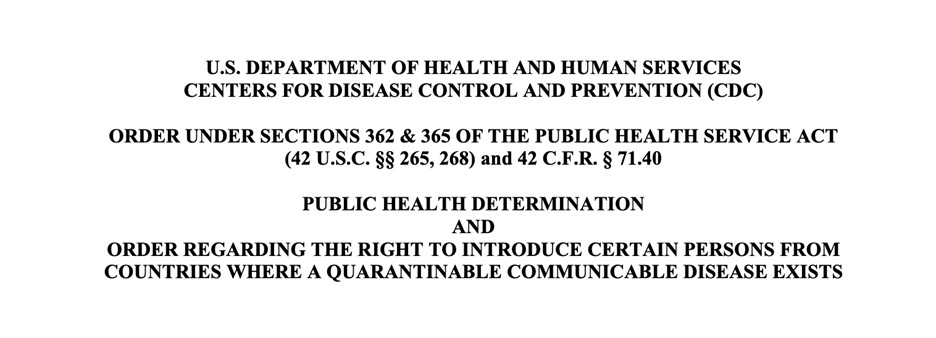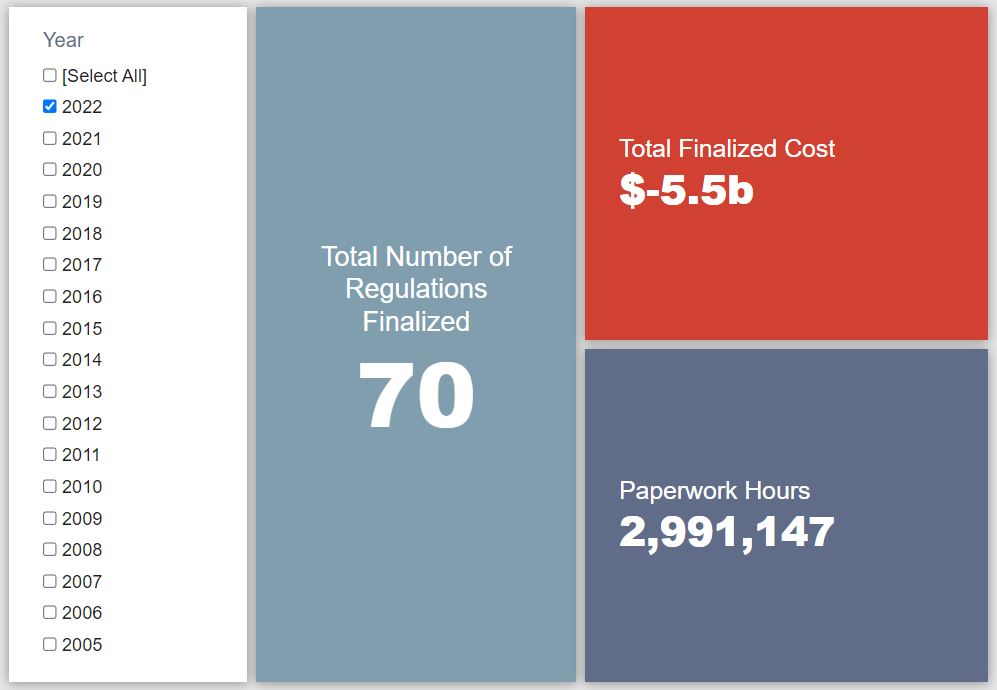Week in Regulation
April 11, 2022
Energy and Environment Regulations Lead Off April
The first full week of April saw not only the long-awaited arrival of baseball’s Opening Day, but also a decidedly active suite of regulations from federal agencies. In the 17 rulemakings with some quantifiable economic impact, energy and environmental policies were the main highlights. In particular, an Environmental Protection Agency (EPA) proposal on ozone emissions and a set of Department of Energy (DOE) efficiency rules provided the most significant regulatory moves. Across all rulemakings, agencies published $15.8 billion in total net costs and added 594,833 annual paperwork burden hours.
REGULATORY TOPLINES
- Proposed Rules: 45
- Final Rules: 68
- 2022 Total Pages: 20,969
- 2022 Final Rule Costs: -$5.5 billion
- 2022 Proposed Rule Costs: $48.1 billion
NOTABLE REGULATORY ACTIONS
The most significant rulemaking of the week was the EPA proposed rule regarding “Federal Implementation Plan Addressing Regional Ozone Transport for the 2015 Ozone National Ambient Air Quality Standard.” The proposal seeks to update “Federal Implementation Plan (FIP) requirements to address twenty-six states’ obligations to eliminate significant contribution to nonattainment, or interference with maintenance, of the 2015 ozone National Ambient Air Quality Standard (NAAQS) in other states.” One week after laying claim to first place in the competition for 2022’s costliest rule to date, EPA is also now in second place for that distinction. Per the proposal’s analysis, affected entities could face $14 billion in total costs.
The other notable development of the week was a trio of rulemakings from DOE regarding energy efficiency standards that yielded a combined $1.8 billion in total upfront compliance costs. The most significant of these in terms of costs was the proposed rule regarding “Energy Conservation Standards for Room Air Conditioners” that brought $2.1 billion in total new costs. Interestingly, one of the trio produced net cost savings in terms of direct compliance costs. The rule regarding “Baseline Energy Efficiency Standards Update for New Federal Commercial and Multi-Family High-Rise Residential Buildings” brings $410 million in total savings, “primarily due to lower HVAC equipment costs for some building types.”
TRACKING THE ADMINISTRATIONS
As we have already seen from executive orders and memos, the Biden Administration will surely provide plenty of contrasts with the Trump Administration on the regulatory front. And while there is a general expectation that the new administration will seek to broadly restore Obama-esque regulatory actions, there will also be areas where it charts its own course. Since the American Action Forum (AAF) RegRodeo data extend back to 2005, it is possible to provide weekly updates on how the top-level trends of President Biden’s regulatory record track with those of his two most recent predecessors. The following table provides the cumulative totals of final rules containing some quantified economic impact from each administration through this point in their respective terms.
![]()
The Biden Administration saw a noticeable decline (approximately $271 million) in its total cost figure. The aforementioned DOE rule regarding efficiency standards for new federal buildings was the primary reason for this net reduction outcome. Across the other two administrations, there was virtually no change in the Trump figures, but there was some notable movement in those of the Obama Administration with nearly $181 million in new costs but 2.8 million fewer hours of paperwork. The primary rule supporting both these trends was a Department of Transportation measure regarding “Electronic On-Board Recorders for Hours-of-Service Compliance” that increased costs by $139 million but cut annual paperwork by 3.1 million hours.
THIS WEEK’S REGULATORY PICTURE
This week, the Biden Administration ends the COVID-19-related border policy known as Title 42.

The Centers for Disease Control and Prevention (CDC) published in the Federal Register on April 6 a “Public Health Determination and Order Regarding Suspending the Right To Introduce Certain Persons From Countries Where a Quarantinable Communicable Disease Exists.” The order, signed by CDC Director Rochelle Walensky on April 1, will end a policy whereby certain migrants are removed from the United States without any immigration processing on May 23, 2022.
The order is known as Title 42 because of the title of the U.S. Code in which its underlying authority is found. The CDC’s order allows the Customs and Border Patrol (CBP) to expel migrants without proper documentation encountered by CBP immediately, rather than be detained in congregate settings, where COVID-19 may have been spread. The order permits the expulsion of those claiming asylum, who under federal law would otherwise be guaranteed consideration.
The first such order of the COVID-19 pandemic was issued on March 20, 2020, by the Trump Administration, and was updated in October 2020. The Biden Administration modified the order upon taking office to exempt unaccompanied minors, but continued to extend the policy, most recently in August 2021.
The orders – and now, their revocation – have been controversial. Many saw the Trump Administration’s initial order as an attempt to use the pandemic to pursue a tighter immigration policy. Those of this view have pressured the Biden Administration to revoke the policy. Others argue the policy was necessary and that revoking it will lead to a surge of migrants attempting to enter the United States.
As with any controversial policy, lawsuits have been abundant. The imposition of Title 42 was challenged throughout its implementation. And the Biden Administration’s latest action has already drawn legal challenges from at least three states – Arizona, Louisiana, and Missouri – casting some doubt as to whether the policy will be allowed to end next month.
TOTAL BURDENS
Since January 1, the federal government has published $42.7 billion in total net costs (with $5.5 billion in new cost savings from finalized rules) and 20.4 million hours of net annual paperwork burden increases (with 3 million hours in increases from final rules).












